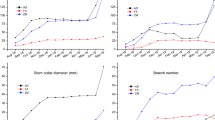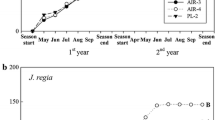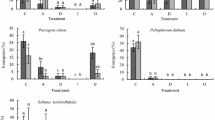Abstract
Merremia boisiana (Gagnep) van Ooststr. is a noxious fast growing woody vine and is able to grow overtop other plants, causing the death of plants underneath and forming monospecies stands. To formulate management responses, we assessed its seed and vegetative reproduction efficacy through indoor and field experiments. The number of flowers counted from bagged infructescences in Guangzhou ranged from 25 to 172, with an average of 80.80. Counting the seeds of bagged infructescences had shown that there were only 1.58 hard testa seeds in each infructescence. Seed vitality tests using red ink indicated that only 68.6% of hard testa and filled seeds were viable. The emergence rate of scarified hard testa seeds in the sand bed was 31.96%. Under imitated natural conditions, 8% of hard testa seeds could germinate, and 9% still retained their germination potential in one year. Thus, seedlings should be monitored and removed in a timely fashion after any attempt of clearing. Moving soil or transplanting plant from infested patches should be strictly prohibited at least for several years. All considered, an infructescence contributed 0.3 seedlings. The investigation in the field found no seedlings either inside or at the perimeter of the patch, suggesting scant expansion by means of seed dispersal. Therefore, the elimination effort could be focused on a relatively restricted scale of patches. Of 630 cuttings of young shoots, old shoots and old lying shoots with or without growth regulators, there were only four (or 0.63%) established individuals. Air-layering shoots all died in two months. Poor cuttings and air-layering reproduction indicated that regeneration from fragments of removed stems or accidentally dropped ones was quite unlikely, and thus mechanical removal was safe.
Similar content being viewed by others
References
Chen B H, Wang R J, Huang X X, Zhou L X (2005). Merremia boisiana: a newly recorded species from Guangdong, China. Journal of Tropical and Subtropical Botany, 13(1): 76–77 (in Chinese)
Li M G, Cheng X Y, Liu B, Yu H (2006). Fast growing and high photosynthetic rate of Merremia boisiana (Gagn.) Ooststrr. Acta Scientiarum Naturalium Universitatis Sunyatseni, 45(3): 70–72, 81 (in Chinese)
Li M G, Zhang W Y, Wang B S, Zhang J L, Zan Q J, Wang Y J (2002). A preliminary study on the seed germination in Mikania Micrantha. Acta Scientiarum Naturalium Universitatis Sunyatseni, 41(6): 57–59 (in Chinese)
Li M G, Zhou X Y (2004). Chapter 8. The ecological control of Mikania micrantha and ecological restoration. In: Wang B S, Wang Y J, Liao W B, Zan Q J, Li M G, Peng S L, Han S C, Zhang W Y, Chen R P, eds. The Invasion Ecology and Management of Alien Weed Mikania micrantha H.B.K. Bei**g: Science Press, 210–217 (in Chinese)
Lian J Y, Cao H L, Wang Z G, Li J, Ye W H, Li J (2007). The community characteristics for invading damage of the forest killer-Merremia boisiana. Guihaia, 27(3): 482–486 (in Chinese)
Liu Z L, Xu H G (2005). A new damaging plant-Merremia boisiana. Weed Science, (2): 58–60 (in Chinese)
Lu X, Zhong Z K, Lin M S, Xu J X, Chen R B (2006). Experiment of chemical control for Merremia boisiana with the benzoate aqueous solution. Journal of Guangdong Forestry Science and Technology, 22(3): 40–42 (in Chinese)
Marushia R G, Holt J S (2008). Reproductive strategy of an invasive thistle: effects of adults on seedling survival. Biological Invasions, 10: 913–924
Myers J, Savoie A, van Randen E (1998). Eradication and pest management. Annual Review of Entomology, 43: 471–491
Panetta F, Timmins S (2004). Evaluating the feasibility of eradication for terrestrial weed incursions. Plant Protection Quarterly, 19(1): 5–11
Putz F E, Chai P (1987). Ecological studies of lianas in Lambir National Park, Sarawak, Malaysia. Journal of Ecology, 75: 523–531
Regan T, McCarthy M, Baxter P, Panetta F, Possingham H (2006). Optimal eradication: when to stop looking for an invasive plant. Ecology Letters, 9: 759–766
Richardson D M, Kluge R L (2008). Seed banks of invasive Australian Acacia species in South Africa: Role in invasiveness and options for management. Perspectives in Plant Ecology, Evolution and Systematics, 10: 161–177
Simberloff D (2001). Eradication of island invasives: practical actions and results achieved. Trends in Ecology & Evolution, 16(6): 273–274
Sun D L, Shen J M, Wan S Q, **e W H (2006). Danger and utilization of Merremia boisiana. Chinese Wild Plant Resources, 25(1): 32–34 (in Chinese)
Tong G J, Chen M R, Yu H B (2005). Preliminary report on the damage of Merremia boisiana. Forest Pest and Disease, 24(3): 17–18 (in Chinese)
Wang B S, Li M G, Liao W B, Li J, Qiu H X, Ding M Y, Li F R, Peng S L (2005)a. Geographical distribution of Merremia boisiana. Ecology and Environment, 14(4): 451–454 (in Chinese)
Wang Z, Yu H B, Liang C F, Yang H M (2005)b. Discussion on the occurring, damage and control of Merremia boisiana. Journal of Hunan Forestry Science and Technology, 32(3): 81–82 (in Chinese)
Wu L F, Liang Y Q, Chen K, Li Z C, Cao H L (2007). Damage and prevention of Merremia boisiana in Hainan Province, China. Journal of Guangdong Forestry Science and Technology, 23(1): 83–86 (in Chinese)
Xu S J, Li W X (1994). Controlling methods on woody vine-Merremia boisiana. Journal of Guangdong Forestry Science and Technology, (1): 46 (in Chinese)
Zan Q J, Wang Y J, Wang B S, Liao W B, Li M G (2000). The distribution and harm of the exotic weed Mikania Micrantha. Chinese Journal of Ecology, 19(6): 58–61 (in Chinese)
Zeng S J, Zheng F, Zeng J, Zheng X P (2005). The effect and reasons analysis of damaging of Merremia boisiana. Journal of Fujian Forestry Science and Technology, 32(4): 6–24 (in Chinese
Author information
Authors and Affiliations
Corresponding author
Rights and permissions
About this article
Cite this article
Li, M., Liu, H., Li, F. et al. Seed, cutting and air-layering reproductive inefficiency of noxious woody vine Merremia biosiana and its implications for management strategy. Front. Biol. China 4, 342–349 (2009). https://doi.org/10.1007/s11515-009-0014-9
Received:
Accepted:
Published:
Issue Date:
DOI: https://doi.org/10.1007/s11515-009-0014-9




